Border Worlds (1986) #1-7,
Border Worlds: Marooned (1990) #1 by Don Simpson
I had these comics as a teenager, and I remember them being really good? But I don’t really remember any specifics. Then again, I was totally into anything that was science fiction, so who knows. Anyway, I’m excited to read this again.
The book starts with a strong hook: “I live in a space suit.”
Which is a bit of a tonal shift from the first five chapters, which ran as backup features in Megaton Man. Those chapters were pretty light-hearted misadventures on a space station, but this seems to be setting a vastly different tone from the first page on.
But then… we get a whole chapter of recaps. It’s not that anything that happened the first five chapters really need explaining — you could just have started them doing some stuff, and then brought in some “Bob, as you know” bits as needed — but not much is needed, really! They have a spaceship! That goes fast! And they need money!
That’s all you need to know.
So if course it goes on and on and on.
But then, the recap chapter is over, and Simpson can start continue the story, and… it’s a very striking shift from the first chapters. The layouts look totally like a Japanese comics, with full bleed printing, and double page spread panels, and things being generally decompressed.
And that’s how the issue ends.
That seventh chapter was very promising — it had a real mood going on, and a feeling that there’s whole world there, and that the characters were going to be interesting. It’s, like, good? Yeah. It’s good.
With the second issue, it becomes clear that Simpson’s approach to the artwork isn’t quite… settled. The first issue had this ultra sharp rendering, and then here we get a few spreads that look quite influenced by Frank Miller’s Ronin.
And some of the characters look way, way more cartooney than the rest.
And then suddenly we’re get a few pages with organic Moebius lines?
But it’s all good! The storytelling is smooth, the mood’s still there, we’re into the characters, and there’s several plot strands that seem likely to be connected in subsequent issues.
These issues are brisk reads, though, even if there’s 32 or 33 story pages per issue.
So Simpson was probably being bombarded with mail saying “I PAID TWO BUCKS FOR THIS AND IT TOOK ME THREE MINUTES TO READ I”M ANGREE”, so he’s saying “but I’m drawing so much shut up” (I’m paraphrasing). Which is fair.
But he seems to capitulate, anyway. Gone are the Japanese-inspired layouts — from here on out, there’s barely a single spread with horizontal panels. But it’s weird — as he’s doing this, and putting in more talking, the story grinds to a halt. We get a lot of talking heads, but no real development of the plotlines.
And the artwork doesn’t feel as exuberant all over, really — it’s more about approaches to filling pages while drawing as little as possible, so there’s entire scenes that are mainly heads floating in oceans of zip-a-tone.
And the layouts get even more traditional.
(Oh, and the bit about living in a space suit? I don’t think we see her in a space suit more than three panels in the entire series.)
Oh, yeah — Kitchen Sink was getting a sort of identity around science fiction/fantasy with artwork in an… Al Williamson? … tradition. These series seemed to be in conversation with each other, somehow — all of them kinda sorta elegiac in tone.
“Corrected Edition”? What’s that about?
Ah:
Pages 4 and 5 are reversed. A corrected edition was subsequently released.
Well, that’s quite extravagant…
The seventh issue sees another dramatic shift in the artwork. Is this Craftint? (It’s paper with two different types of tone present in the paper, and you can use a brush with two different chemicals to bring it out.) It almost always looks like a total mess when printed, and this is certainly isn’t… pretty.
If it’s not Craftint, Simpson’s spent a lot of time cutting zip-a-tone.
Anyway, the seventh and final issue doesn’t resolve anything, but that’s because they didn’t know that that was the final issue at the time. But I think you can tell by the waffling in the storyline and the phoned-in artwork that Simpson had lost interest. Or, if not lost interest, then perhaps he just had to take up other work because circulation had fallen? This was, after all, during the Black and White Bust.
So three years later…
… we get the issue that was going to be Border Worlds #8, apparently. But they’ve restarted the numbering at #1.
And as with Border Worlds #1, it’s not a very good #1 if you want to draw in new readers.
And the layouts have now gone completely traditional, and there’s not much of interest in the artwork.
Oh, yeah, Simpson would start doing porn comics for Fantagraphics shortly afterwards, I think?
In any case, this issue doesn’t wrap up anything, because the series was supposed to continue. But I’m assuming that sales sucked, once again, and Simpson had to abandon the project again.
So that was the state of affairs for a few decades — one of the many “lost” comics of the 80s: Without an ending, you can’t really collect it.
Dover Books to the rescue! Over a very weird couple of years, they got in touch with creators of these “lost” 80s comics series and had them whip up some endings for the things, and they published them as (cheap) hardcover collections. This didn’t last very long, so either they ran out of these sort of books, or they didn’t sell all that well.
Hm… They did more books than I remembered in the 2009-2016 era.
Simpson manages to tie up a number of the plot lines in the additional pages — certainly much better than the new ending to Puma Blues (which really sucked).
It’s an almost kinda satisfying ending?
But as a book, it’s a mess. It shifts between all these different tones and rendering styles, and it doesn’t really cohere. The chapters that work (approx 7 to 10) are kinda special.
Comics Scene Volume #2, page 41:
At the time, though, Simpson
thought Border Worlds could follow
Megaton Man’s sales history, giving
him a second shot at stardom. “It
seemed like a real safe bet,”
says
Simpson, “The black-and-white boom
was just starting. Border Worlds #1
sold about 20,000. After that, it
dropped like a rock.”
Simpson blames a plummeting in-
dependent market for the death of his
darling. “In the early ’80s, everyone
was clamoring for diversity of mate-
rial and more mature stories,” he ex-
plains. “We were just coming off
Elfquest and Star *Reach [two pio-
neering independents]. But DC and
Marvel co-opted all that energy, espe-
cially with The Dark Knight Returnsu
Suddenly, everyone wanted to be like
Frank Miller, and do the definitive
Spider-Man or something.”
Kitchen, in turn, says Simpson’s
180-degree turn from satire to straight
science fiction alienated fans, a mis-
take he says has repeatedly hobbled
Simpson’s series-hopping career (five
Kitchen Sink first issues in 1989 and
1990). “Don has always been very
mercurial,” Kitchen says.
“In my
view, he has lost fans each time he
changed books. He’s more concerned
about his own artistic impulses than
about satisfying readers who are
interested in him. I expected that Don
would have been a superstar by now.
“He also did something that was
market poison: He took Border
Worlds, which was an all-ages book,
and made it X-rated midstream.” The
book lived up to its Mature Readers
tag with nudity in its last two issues,
#6 and #7.
There is yet another possible rea-
son for Border Worlds’ failure: It was
just plain slow going, perhaps the
talkiest SF comic ever. Simpson even
had to scrap an action-promising
cover for #1 as too misleading.
AH: So why have you returned to
Megaton Man ?
SIMPSON: This mini-series started
in January of ’87. I was still working
on Border Worlds then and I wasn’t
sure what format it would take. I was
thinking ofa long story, or a double-
issue, or something like that and
I had no deadline. I was doing it just
as a relief from doing Border Worlds.
The two things are so different that
going from one to the other was a
good break. The only problem of
course is that Border Worlds kept
dropping in sales to the point where
I had to take on freelance work—I did
an issue of the Justice Machine and
inked a Mr. Monster. Then I got roped
into Wastelands at DC. All These
things just tended to take its toll on
Border Worlds in terms of my atten-
tion to it and by the time of issue #7
I just felt that I was being distracted
to the point that I was worried I was
going to hurt the quality of the book.
Actually I think steadily the series
kept getting better. If anything I think
it was getting much stronger and I was
getting deeper into it. That was the
problem: I wanted to be fully
absorbed with it, but out of necessity
I had to juggle different things which
doesn’t make for peace of mind. So
by the time I suspended Border
Worlds everyone told me that by
suspending it I was in effect cancell-
ing it. Of course I had every intention
of returning to it as soon as possible.
I was treating the freelance stuff as
stop-gap measures—stuff to do to get
back on track and,wait for the market
to return.
In the meantime, I was still doing
bits and pieces of the Megaton Man
mini-series and it was growing closer
to being finished.
AH: On Border •Worlds, which you
said you thought was getting better
with every issue, what elements did
you think were improving?
SIMPSON: well, 1 was learning
more about characterization, about
form and pacing … There was a lot
of experimenting with Border Worlds
from the back-up feature in the last
few issues of Megaton Man to the
black-and-white book. I was learning
to draw in black-and-white which is
a lot different from relying on color.
So, I was experimenting with silhouet-
tes, a lot of black… by the 7th issue
Iwas using duoshade/craft-tint which
is probably associated with the
Teenage Mutant Ninja Turtles more
than anything else. Overall I think I
was getting Border Worlds down.
In the 6th and 7th issues there were
more panels to a page. One of the
complaints I heard a lot was—
especially on the early issues which
had a lot of double-page splashes—it
seemed like when you read an issue,
not a lot had been accomplished. I
think by the later issues things were
beginning to move and pay off.
6. Border Worlds
This stark, dramatic series
seemed almost to have wormed its
way into my consciousness quite
unexpectedly. I had never read a
single installment of the five open-
ing chapters that appeared in the
back of Megaton Man last year.
Donald Simpson’s striking illustra-
tions compelled me to purchase the
first issue when the strip was given
its own book–three issues of which
have appeared to date. Three—but
after only one I was convinced this
‘would be an outstanding series. I
think time has confirmed the validity
of this particular bit of intuition.[…]
But, perhaps more than any other
book in my Top Ten, it is the sheer
power of the illustrations that car-
ries this title awe,y from the common
herd.
Most often, comic book science
fiction seems wedded to Star
Wtzrs–all gloss and glitter. The only
glitter found here is the occasional
ray of light reflecting from the sur-
face of a besmudged helmet. Simp-
son’s space ships don’t look like
special effects—but like blocks of
fully functional machinery. Space
suits are born of practicality. not
designed by Dior. This is a world
of juxtapx)sed light and shadow–
with the shadow seeming always to
hold the advantage. It is a tough
world, beaten down by the harshness
of reality.
The Comics Journal #117, page 61:
A chief virture of Donald Simpson’s
Border Worlds is that it focuses on the
thoughts and feeliws of Jenny Woodlore,
a novice from Earth who begins a space
shuttle operation on Chrysalis, a magnifi-
cent domed space station in the Arcameon
star system. Throughout the series, Simp•
son anchors his epic tale in human sensi-
bility by intermittently pulling us back to
Jenny’s point of view. For example, the
first issue commences with a monologue
in which Jenny laments the relentless
routine and monotony Of her work. The
drab. banal way Jenny talks about her life
may seem off-putting at first (and Simp-
son uses uninvitingly dense blocks of text
to get things off to a slow start), but Simp-
son wins you over. The first issue sets the
right tone of vaguely disillusioned melan-
choly that permeates Jenny’s life, and
when Jenny relates an instance of sexual
fantasy, that led to “a fleeting moment
of satisfaction,” Simpson has successfully
captured the sense of a human being’s
private longings and disappointments.
Like Alien Fire, Border Worlds aspires
to the texture and complexity of serious
science fiction in comic book form. In this
effort, Simpson is generally successful,
and the series should appeal to fans of
seriously-intended genre work. The ingre-
dients are perhaps too familiar—one plot
line has to do with efforts to prevent the
imminent destruction of Chrysalis as it
drifts out Of orbit, another involves a
fuÉtive brother and sister who are sought
by authorities because they possess the
knowledge necessary to create a “black
hole bomb” —and you sometimes wish
Simpson would get on with it. The
emphasis on mood and atmosphere feels
like dawdling, but the storytelling is never
less than intelligent.
Simpson has settled on an unusual
visual approach for Border Worlds. He
rarely draws more than three panels ner
page, and he occasionally dedicates an
entire page to a single panel. As part of
this scheme, the art has been reproduced
on a scale that is larger than we’re accus-
tomed to seeing in comics—that is, we
see panels that in most mainstream comics
would be reproduced at half the scale
Simpson employs. Though I admire
Simpson’s aspirations, I was put off by
the self-conscious, arty expansiveness of
the first two issues—Simpson’s renderings
of the human face and form has a cer-
tain caricatural quality that is less appeal-
ing than it might be, and a bit more
aesthetic distance seems called for—but
I also appreciate that Simpson wants you
to see these image with absolute clarity.
(Simpson appears to have been influenced
by the freedom of Japanese comics.)
Bruce Canwell writes in Amazing Heroes #181, page 86:
BORDER WORLDS:
MAROONED #1Around here, Sunspot Comics is the
“hot” place to shop, thanks to its
manager, Bing Baxterbook. Bing may
talk like a dockwalloper, but he knows
his comics: three years before DC’s
Crisis he was predicting that Wally
West would take (wer as the Flash, and
he pushed for Hawkeye to lead an
Avengers lineup that was remarkably
similar to what became the original
West Coast team. I don’t agree with
all of Bing’s opinions, but when he
talks, I listen.
Case in point: Bing looked at my
copy of Border Worlds: Marooned #1
and grunted, “Wotta disappointment!”
I was flabbergasted, “Wait a minute.
This comic’s by Don Simpson, right?
The guy you practically lionized for
his work on Megaton Man, Waste-
land, and Alan Moore’s “Pictopia?”
How can it be a bomb?”
“I’ll level with ya,” Bing said.
Making sure no minors were about,
he opened the comic to page 12. “It’s
this sex scene that bothers me.”
I examined the pages in question
and shrugged. “Looks like an honest,
natural depiction of lwemaking to me.
86
It’s explicit, yeah, but it’s tastefully
executed.”
“It’s tasteful, awright—is it neces-
sary, though? I don’t need to see
penetration t’ figger out that two
people are makin’ it, not if the creator
is doing his job. It’s like Simpson
tossed this scene in just because he
wanted to, not because it was the best
way to convey what was happening.
To my eye, that’s gratuitous, that’s
what it is.”
“But it says ‘Adults Only’ right on
the cover.”
“Well, when I say, ‘This comics for
adults,’ I like it to be ’cause the plot,
characterizations, and themes are
more subtle than the usual super-doop
punch-’em-ups, not ’cause there’s a
buncha writhing, sweaty bodies
inside.”
I understand Bing’s point, but my
problems with Border Worlds is less
with its sexual content than with its
cold, claustrophobic feel and perva-
Sive sense of hopelessness. It’s all
sophisticated and well-clone—which is
a tribute to Simpson’s skills as a
cartoonist—but it’s not exactly an
uplifting reading experience.
The bottom line is Border Worlds
is an ambitious but flawed experiment
from an extremely talented writer-
This is the eighty-fourth post in the Entire Kitchen Sink blog series.
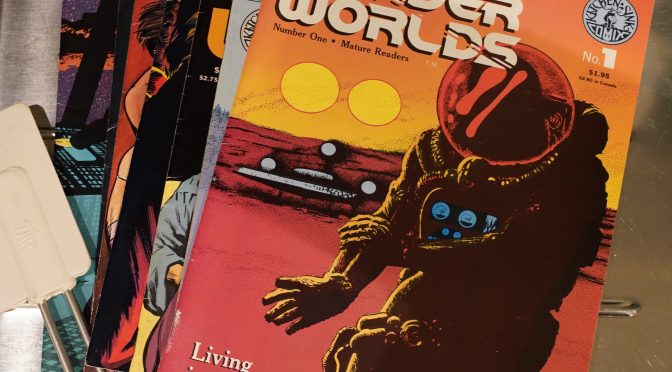
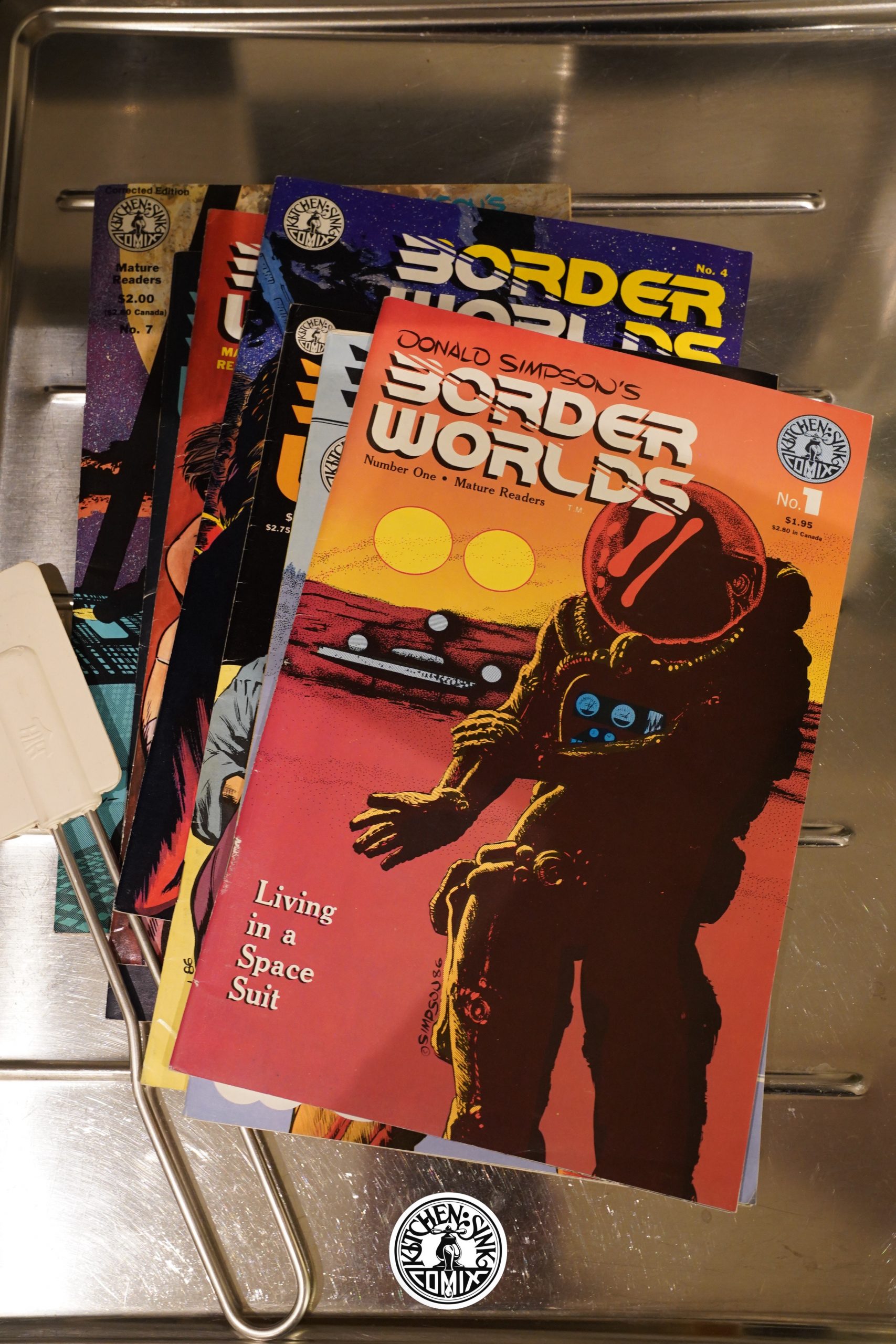
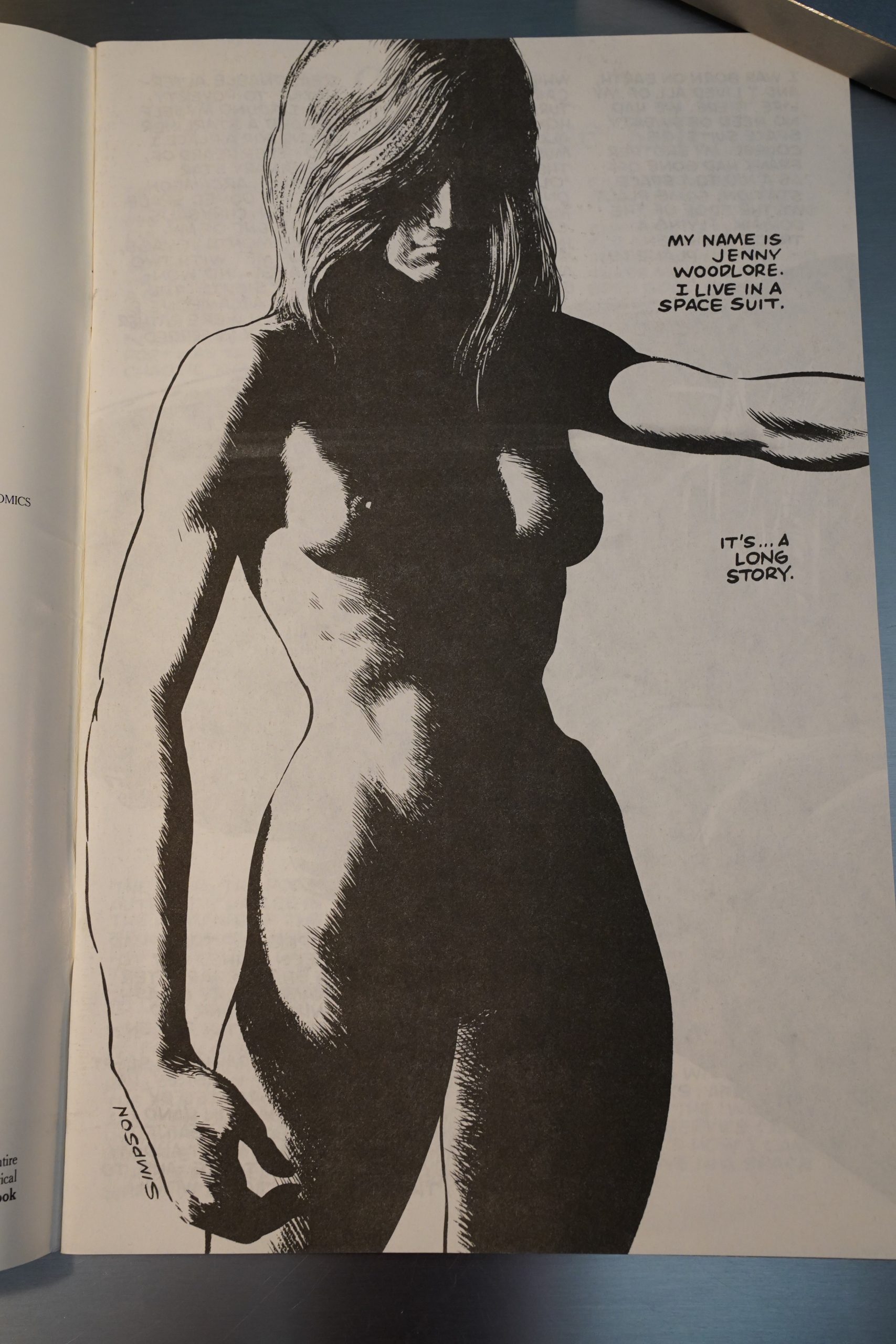

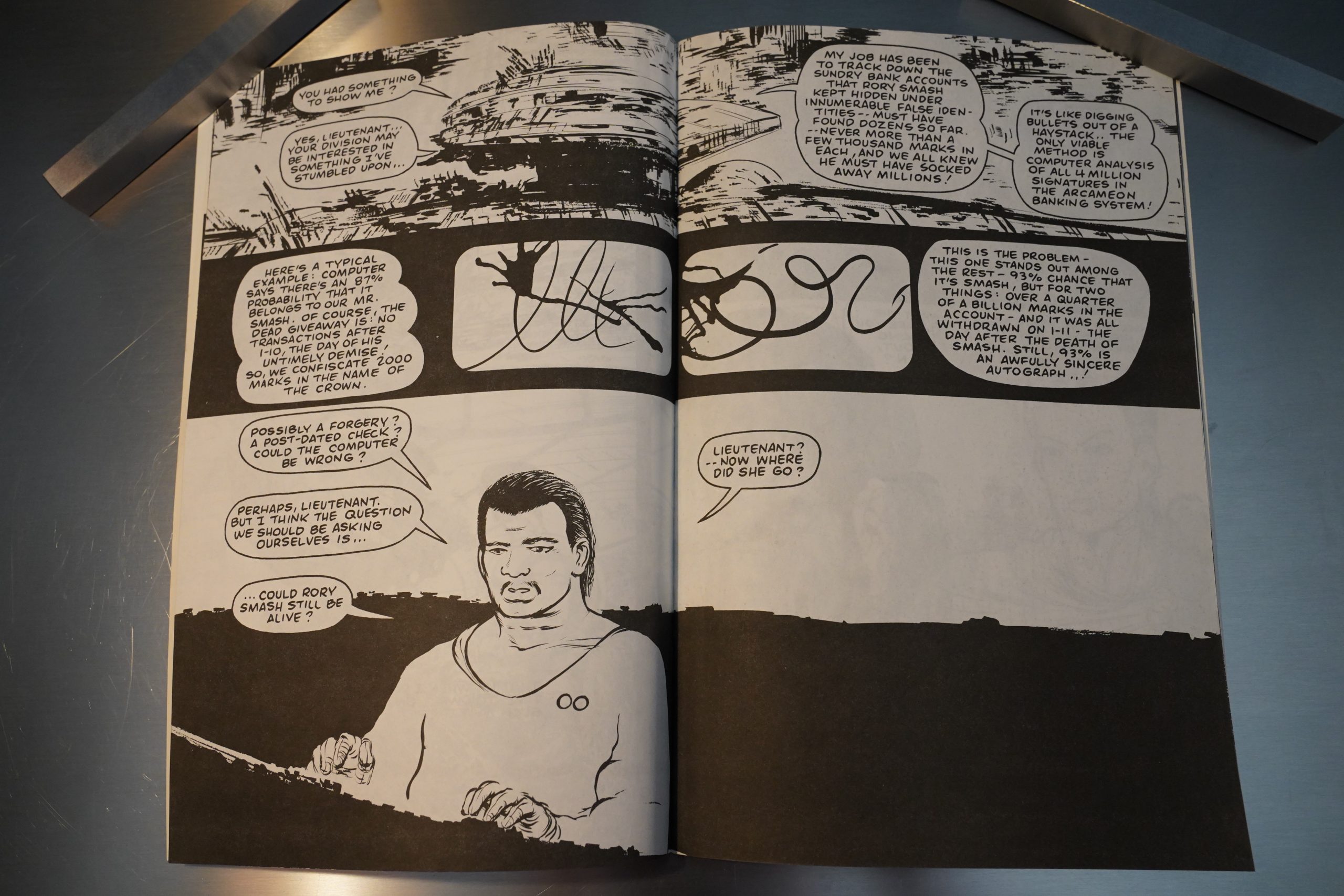
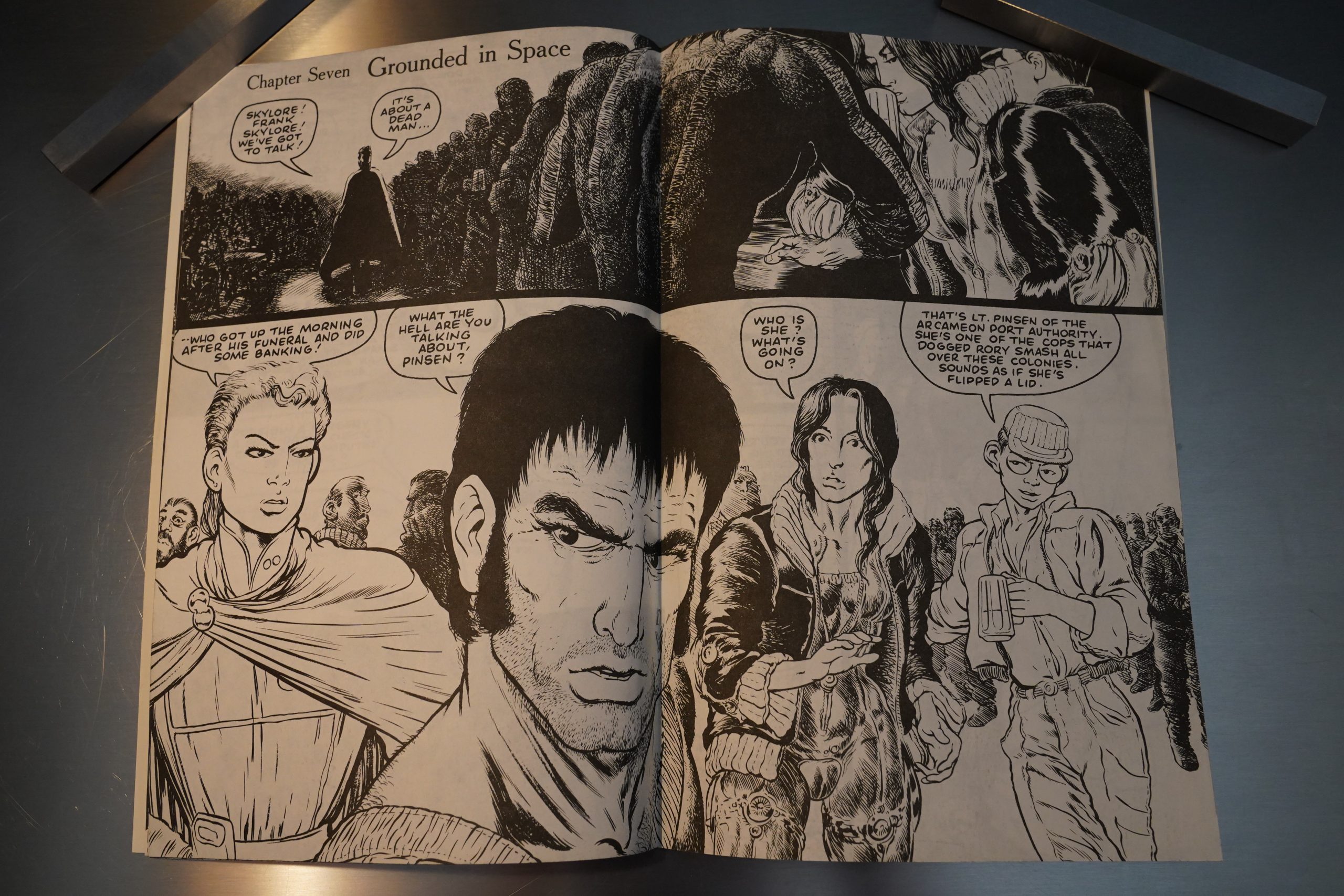

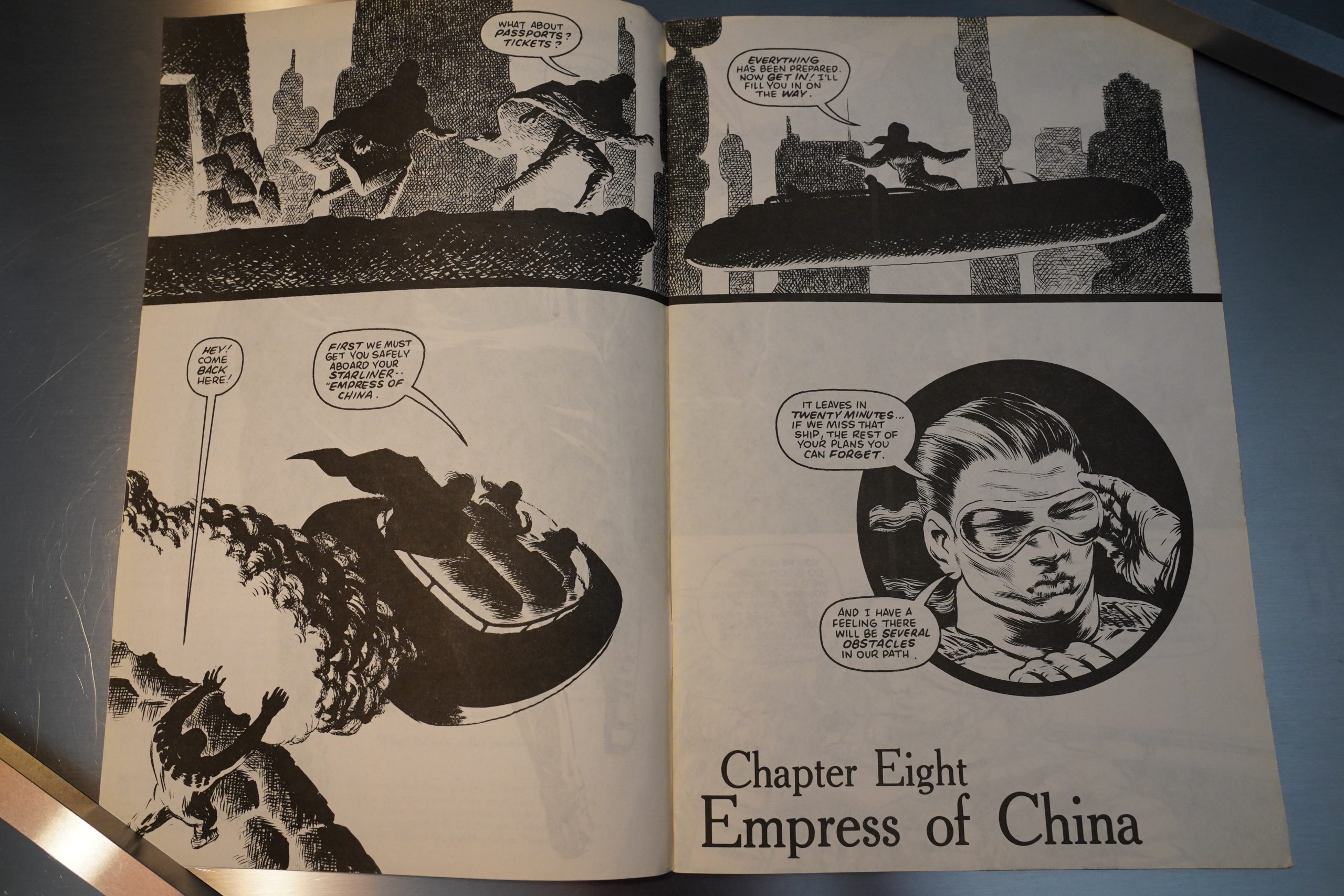
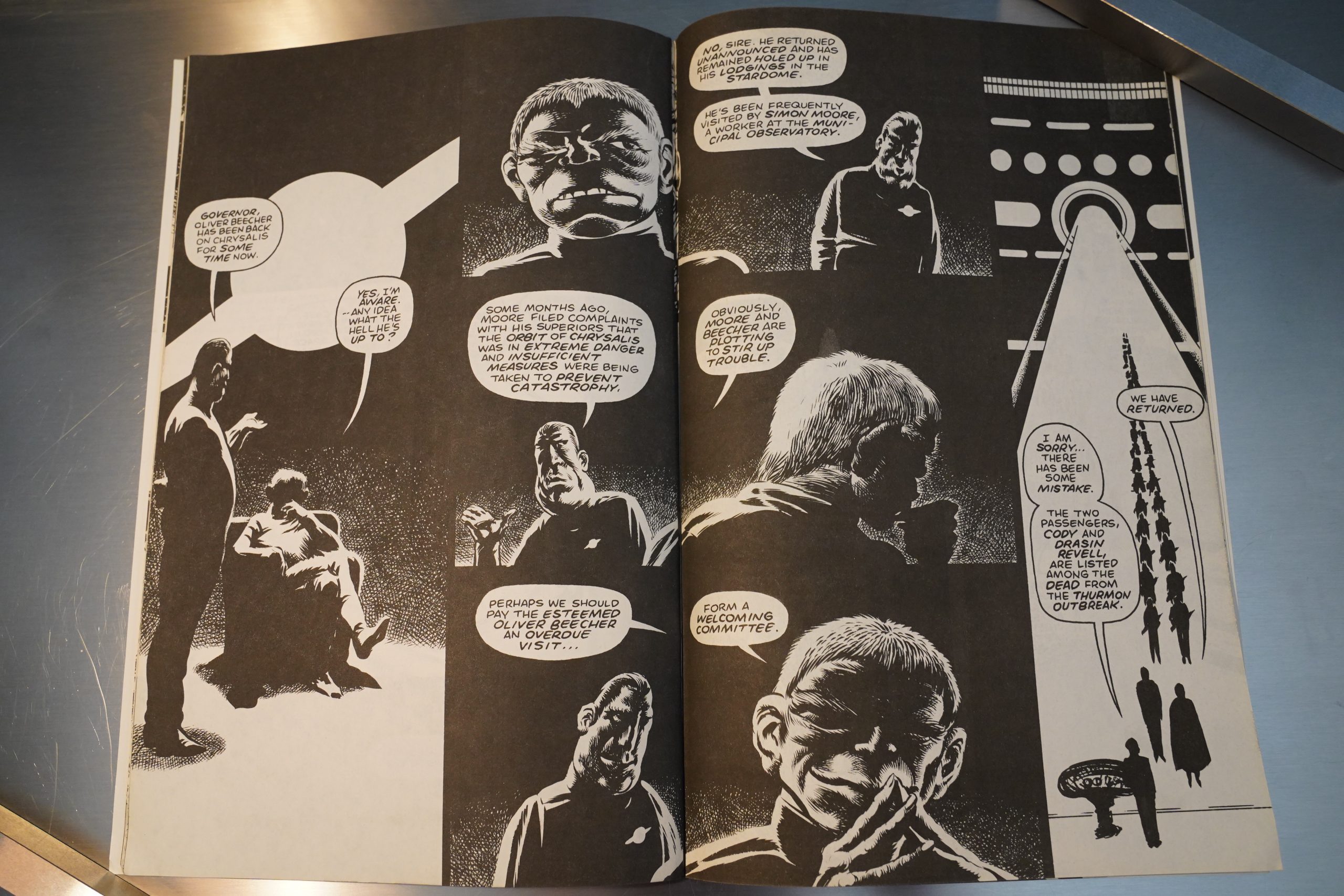

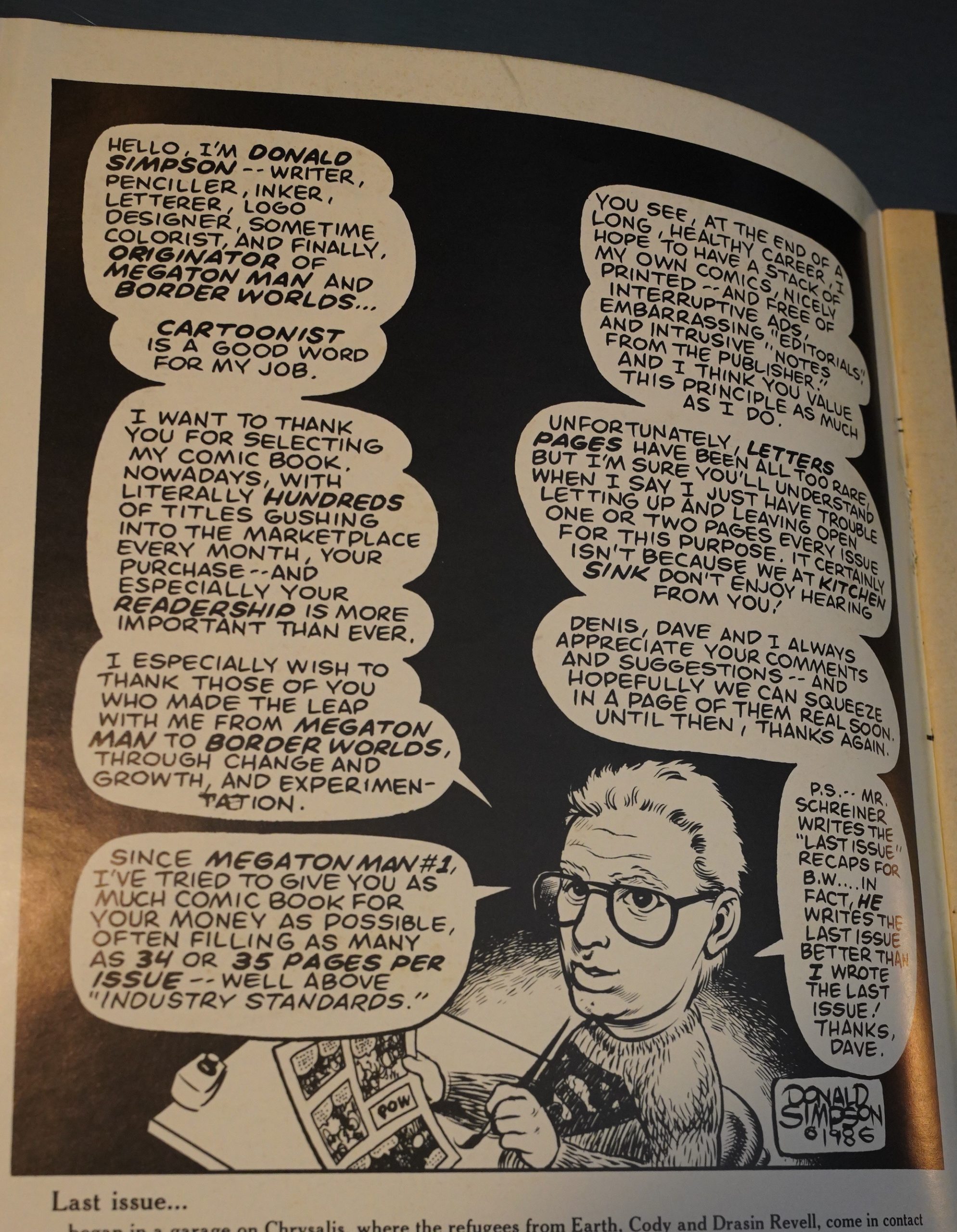
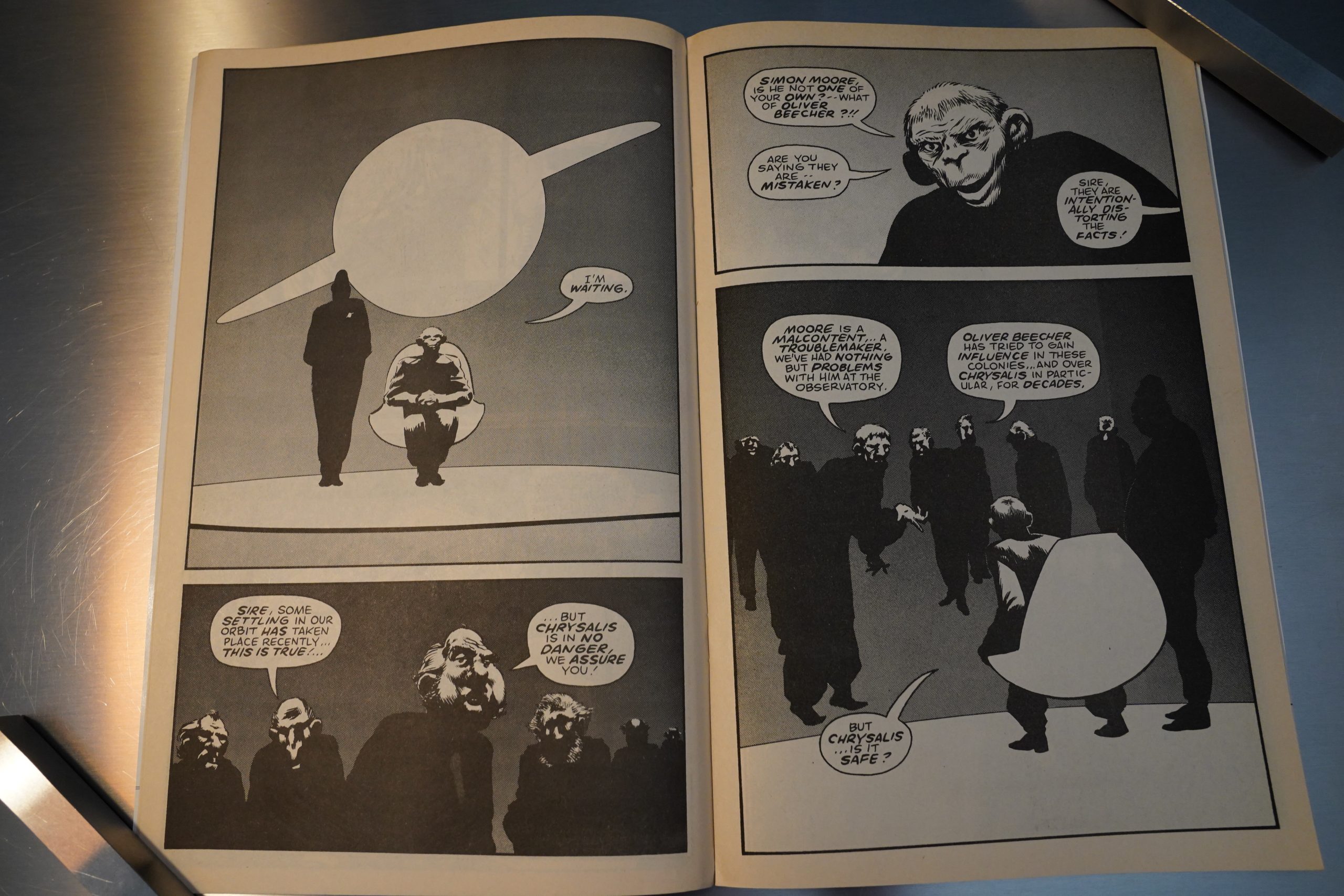
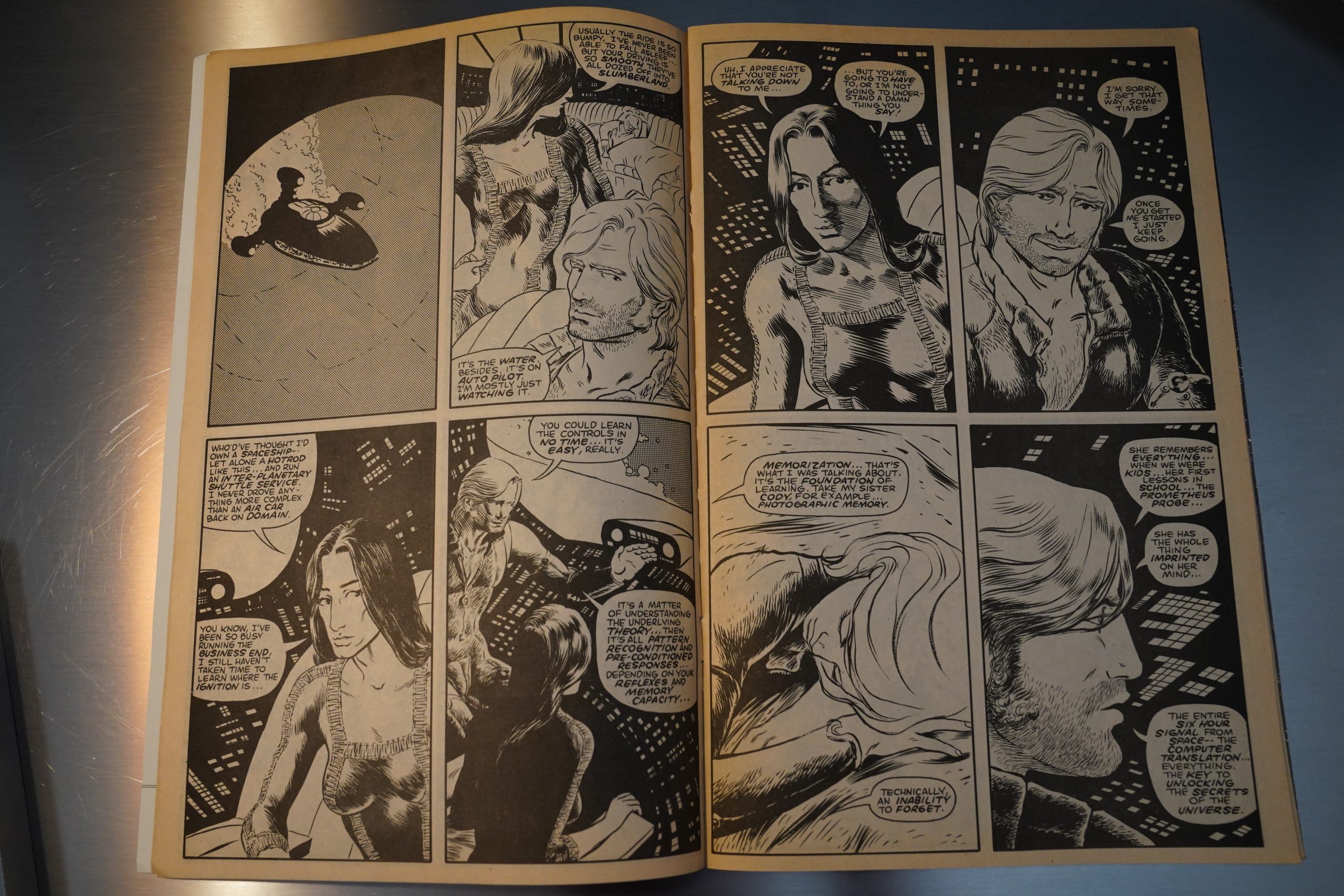
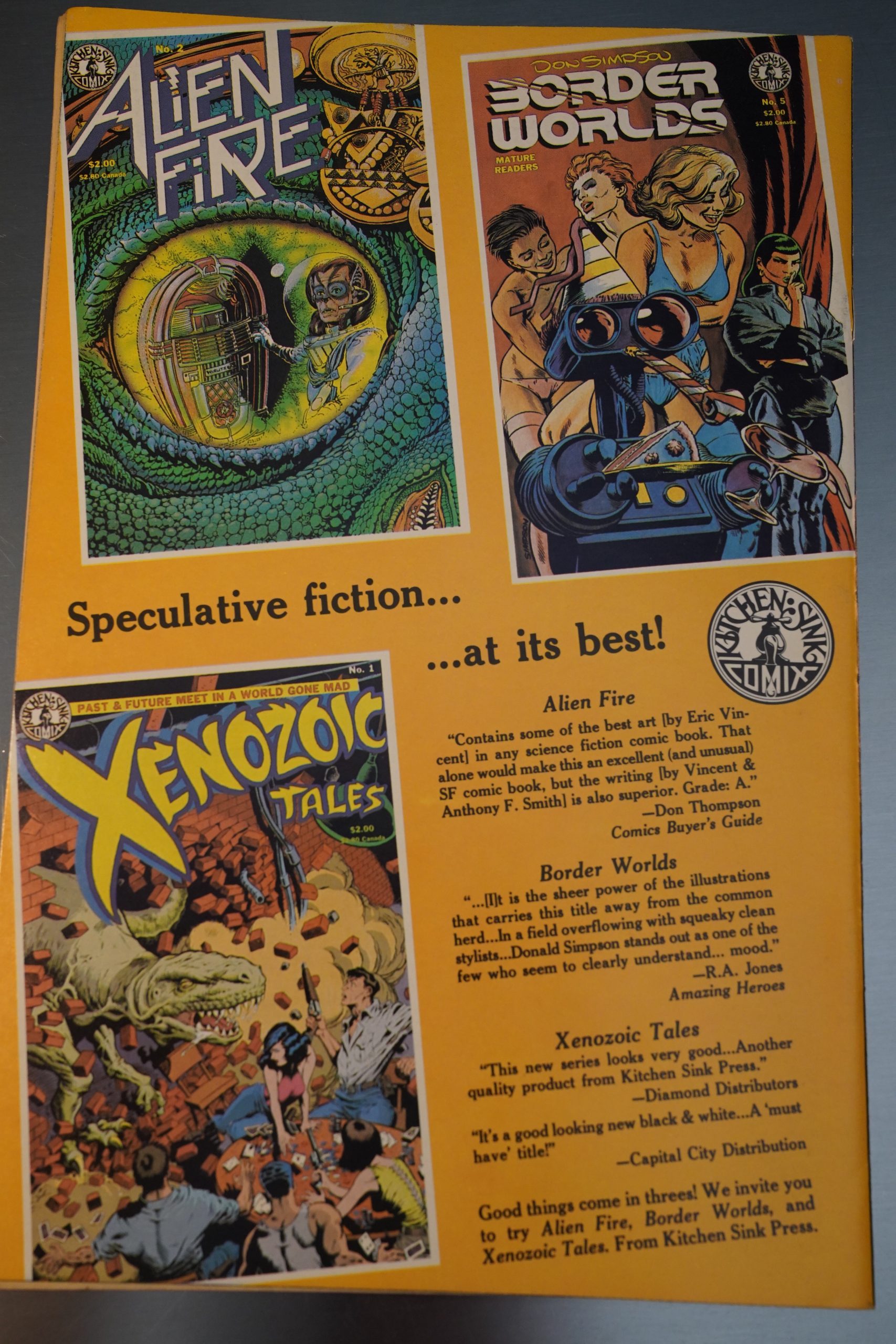
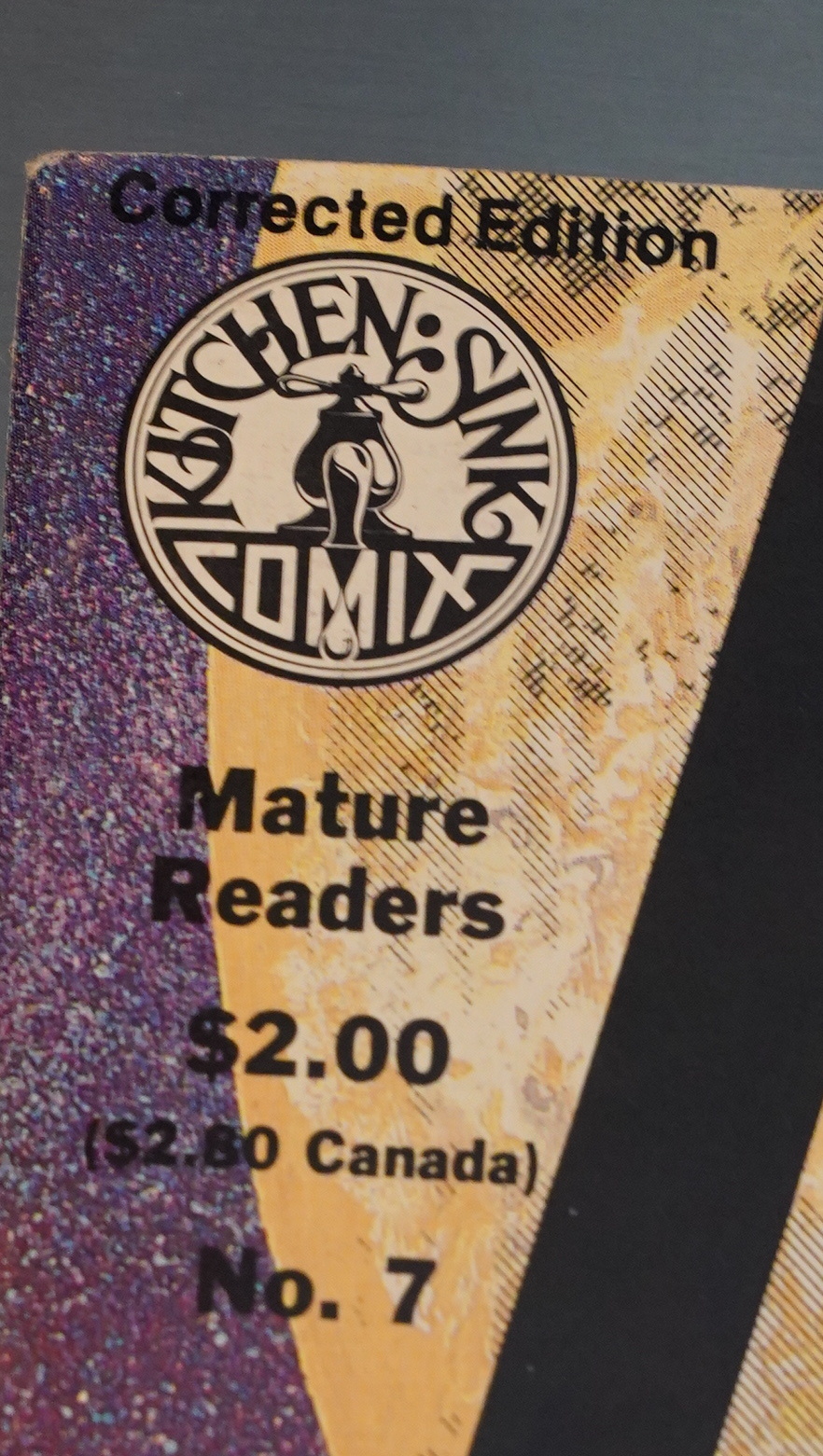

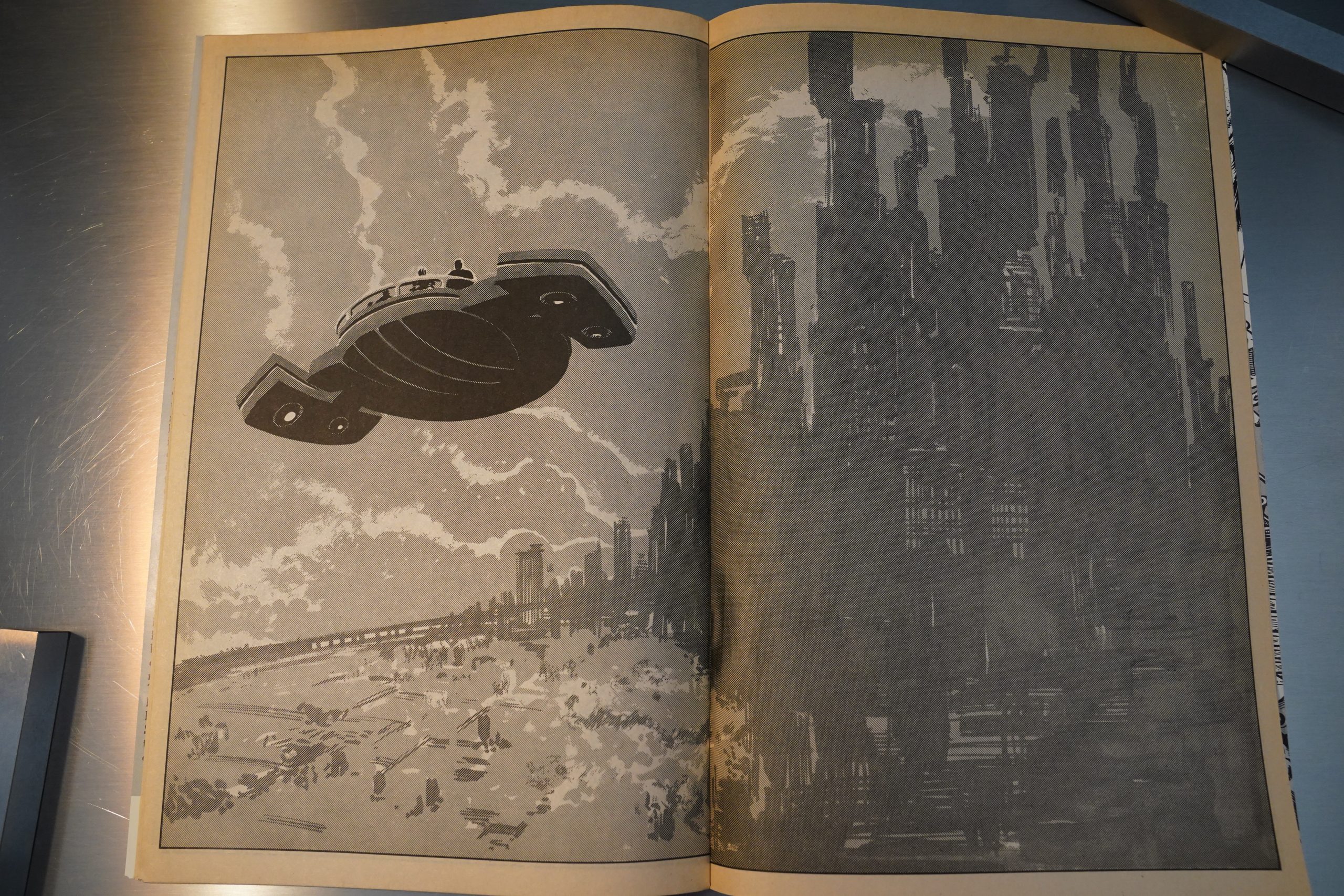

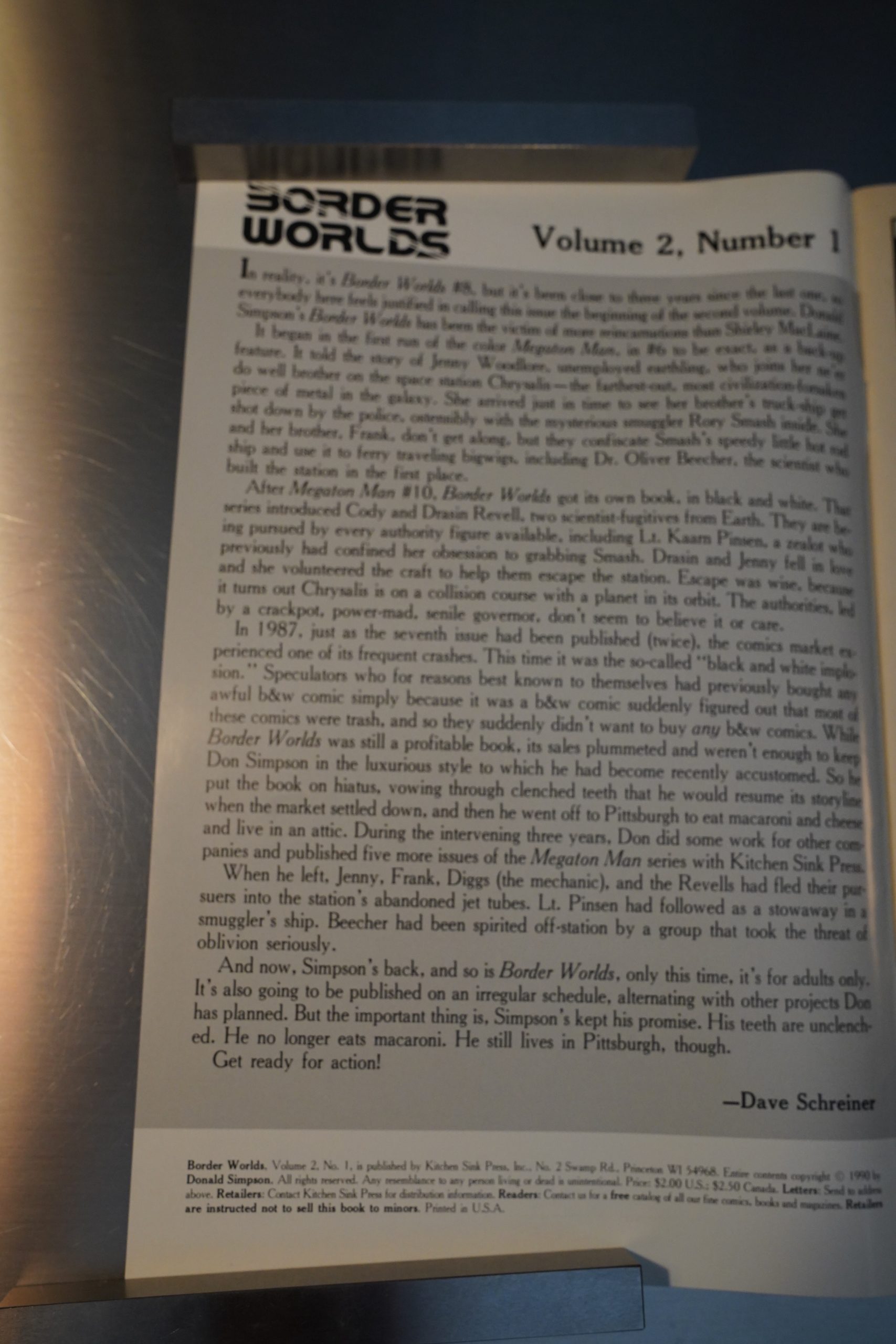
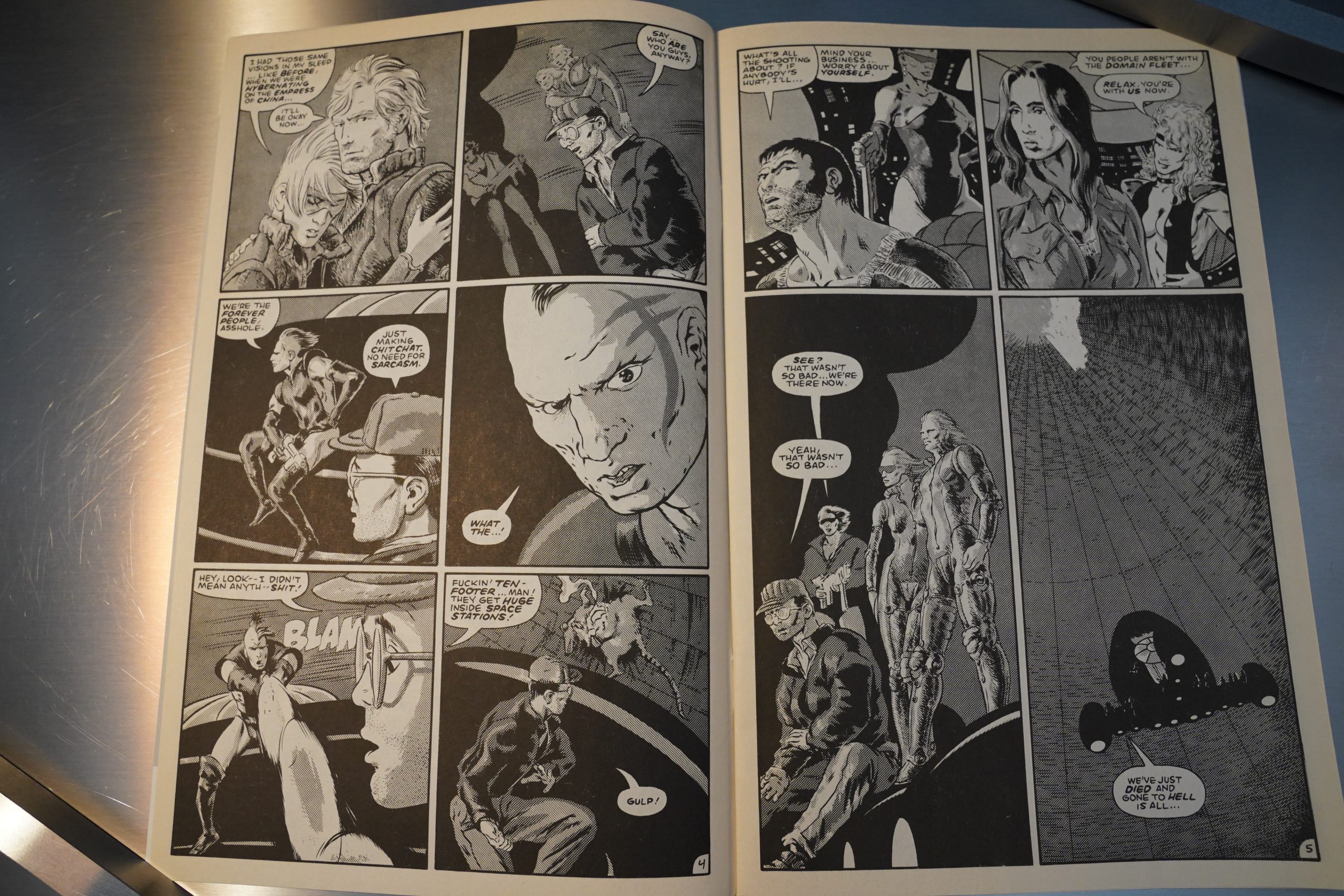
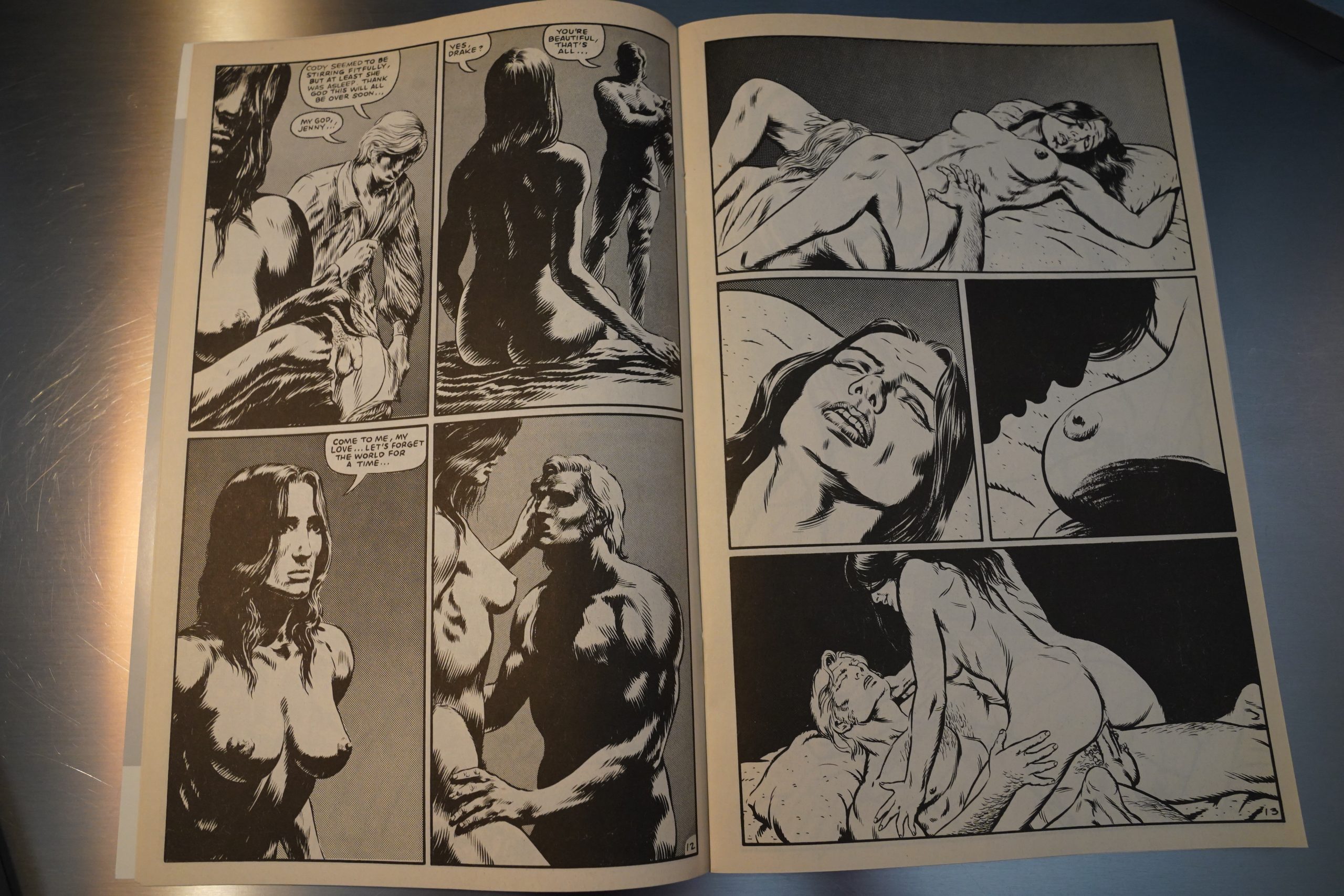
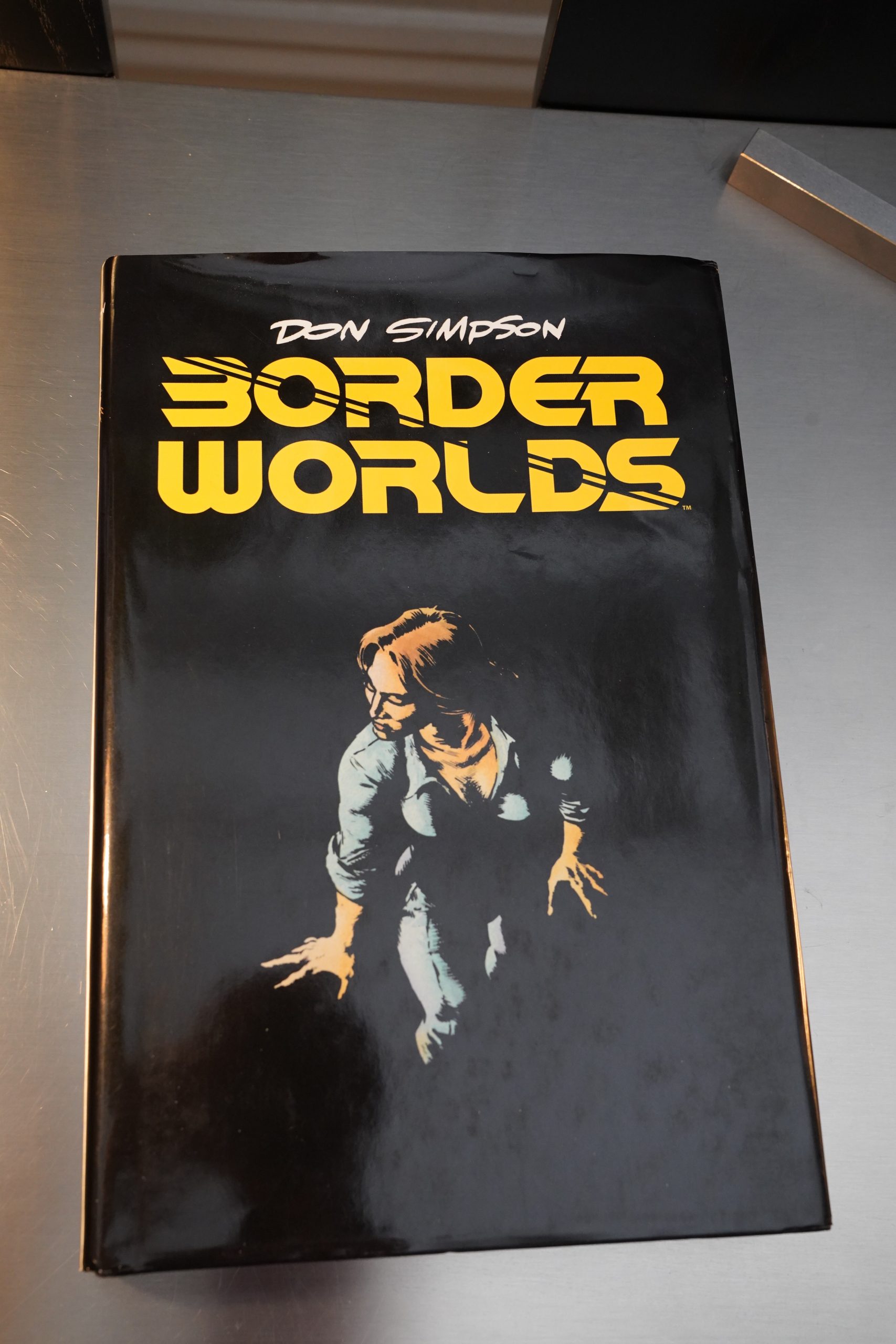
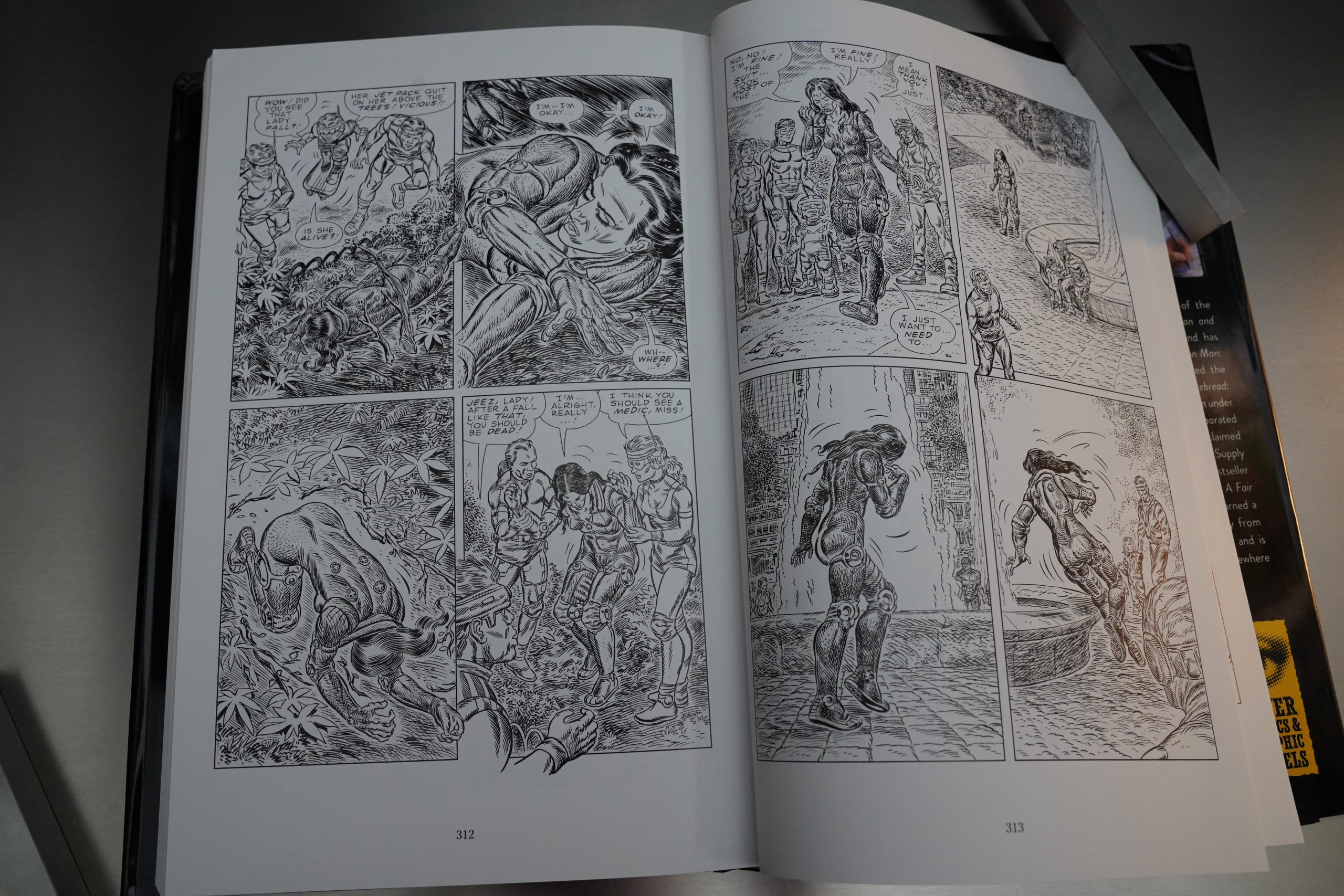
Pingback: facebook.com